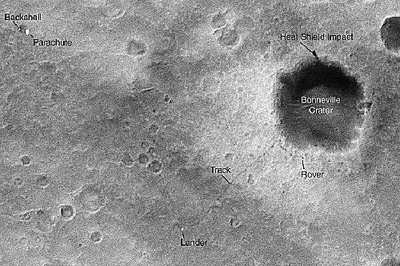Mars Global Surveyor Fine Tunes The Focus
NASA's Mars Global Surveyor, starting its third mission
extension this week after seven years of orbiting Mars, is using an
innovative technique to capture pictures even sharper than most of
the more than 170,000 it has already produced.

One dramatic example from the spacecraft's Mars Orbiter Camera
shows wheel tracks of NASA's Mars Exploration Rover Spirit and the
rover itself. Another tells scientists that no boulders bigger than
about 1 to 2 meters (3 to 7 feet) are exposed in giant ripples
created by a catastrophic flood.
"Over the past year and a half, the camera and spacecraft teams
for Mars Global Surveyor have worked together to develop a
technique that allows us to roll the entire spacecraft so that the
camera can be scanned in a way that sees details at three times
higher resolution than we normally get," said Dr. Ken Edgett, staff
scientist for Malin Space Science Systems, San Diego (CA), which
built and operates the Mars Orbiter Camera. The technique adjusts
the rotation rate of the spacecraft to match the ground speed under
the camera.
"The image motion compensation is tricky and the spacecraft does
not always hit its target. However, when it does, the results can
be spectacular," Edgett said.
The Mars Orbiter Camera acquires the highest resolution images
ever obtained from a Mars-orbiting spacecraft. During normal
operating conditions, the smallest objects that can be resolved on
the Martian surface in these images are about 4 to 5 meters (13 to
16 feet) across. With the adjusted-rotation technique, called
"compensated pitch and roll targeted observation," objects as small
as 1.5 meters (4.9 feet) can be seen in images from the same
camera. Resolution capability of 1.4 meters (4.6 feet) per pixel is
improved to one-half meter (1.6 feet) per pixel. Because the
maneuvers are complex and the amount of data that can be acquired
is limited, most images from the camera are still taken without
using that technique.
Mars Global Surveyor began orbiting Mars on Sept. 12, 1997.
After gradually adjusting the shape of its orbit, it began
systematically mapping the planet in March 1999. The Mars Orbiter
Camera's narrow-angle camera has now examined nearly 4.5 percent of
Mars' surface, including extensive imaging of candidate and
selected landing sites for surface missions. The Mars Orbiter
Camera also includes a wide-angle camera that observes the entire
planet daily.
"Mars Global Surveyor has been productive longer than any other
spacecraft ever sent to Mars, since it surpassed Viking Lander 1's
longevity earlier this year and has returned more images than all
past Mars missions combined," said Tom Thorpe, project manager for
Mars Global Surveyor at NASA's Jet Propulsion Laboratory, Pasadena
(CA). The mission will complete its 25,000th mapping orbit on Oct.
11.

Principal goals for the orbiter's latest mission extension,
beginning Oct. 1, include continued weather monitoring to form a
continuous set of observations with NASA's next Mars mission, Mars
Reconnaissance Orbiter, scheduled to reach the red planet in 2006;
imaging of possible landing sites for the Phoenix 2007 Mars Scout
lander and 2009 Mars Science Laboratory rover; continued mapping
and analysis of key sedimentary-rock outcrop sites; and continued
monitoring of changes on the surface due to wind and ice. Because
the narrow-angle camera has imaged only a small fraction of the
surface, new discoveries about surface features are likely to come
at any time. The extension runs two years, through September 2006,
with a budget of $7.5 million per year.
Dr. James Garvin, NASA's chief scientist for Mars and the Moon,
said, "Mars Global Surveyor continues to catalyze new science as it
explores Mars at scales compatible with those that our Mars
Exploration Rovers negotiate every day, and its extended mission
will continue to set the stage for upcoming observations by the
Mars Reconnaissance Orbiter."
 ANN's Daily Aero-Term (04.24.24): Runway Lead-in Light System
ANN's Daily Aero-Term (04.24.24): Runway Lead-in Light System ANN's Daily Aero-Linx (04.24.24)
ANN's Daily Aero-Linx (04.24.24) Aero-FAQ: Dave Juwel's Aviation Marketing Stories -- ITBOA BNITBOB
Aero-FAQ: Dave Juwel's Aviation Marketing Stories -- ITBOA BNITBOB Classic Aero-TV: Best Seat in The House -- 'Inside' The AeroShell Aerobatic Team
Classic Aero-TV: Best Seat in The House -- 'Inside' The AeroShell Aerobatic Team Airborne Affordable Flyers 04.18.24: CarbonCub UL, Fisher, Affordable Flyer Expo
Airborne Affordable Flyers 04.18.24: CarbonCub UL, Fisher, Affordable Flyer Expo




